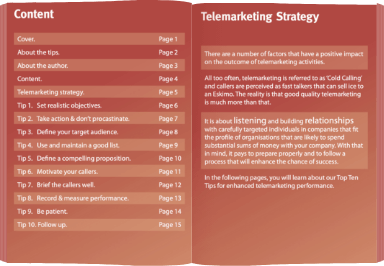Unless you’re flooded with fresh sales enquiries, you probably need to do something to promote your business in order to generate new business opportunities. But where do you start? There are so many options. And those options come with so many promises and false dawns. Whether you’re using SEO, PPC, Direct Mail, Email Marketing, Social Media marketing, Advertising (on or offline), Telemarketing or one of any number of other marketing solutions, there’s no guarantee that the route you choose will work. And, what does ‘work’ mean? That’s surely a relative thing and, what’s a realistic goal for lead generation, especially from a standing start?
What’s Does Your Pipeline Look Like?
A strong new business pipeline indicates the health (or lack of health) of a business. A steady flow of qualified leads is what we need to ensure that the organisation is focused on growth and insulates itself against the somewhat inevitable periodic loss of clients for one reason or another. So, we’ve established that sales leads are important. But, how do we get them at a price per lead that doesn’t break the bank? And how do we get enough of them to make a difference?
These are key questions with which many businesses wrestle. It doesn’t help that some marketing and lead generation suppliers promise the earth and deliver closer to dust. Maybe they over-promise and under-deliver. And maybe, client expectations are unrealistic. Or it’s possibly a combination of the two.
Success Drivers for Lead Generation
The reality is that generating sales opportunities, in a cluttered and competitive environment, is challenging. There are few quick wins and there is no fixed recipe for success. Equally, success means different things to different people.
Typically, the results you get will depend on the:
- Type Industry / sector – some are tougher to penetrate than others
- Level of focus – Are your marketing and sales messages targeted at one sector or are you aiming at lots of targets at the same time? – Jack of all trades?
- Size of target company – Bigger companies have more layers and barriers
- Ease of reaching the decision maker – the higher you go, the harder it is
- Value of sale – larger sales take longer to come to fruition
- Level of competition in the marketplace
- Amount of activity, time and money that you devote to lead generation
- Your credentials versus your key competitors
- How well you articulate what you offer in print and person to person
- Any calls to action you use to drive response
The above isn’t everything of course, but it illustrates that lead generation isn’t simple and there is no simple solution.
Miracles are at a Premium
There are all manner of considerations. You can’t expect miracles. And, you have to be prepared to be in it for the long game. You might like to think that you can do a burst of activity to provide the impetus for business growth. Yet, invariably, a stop-start approach to marketing and business development is doomed to failure since you build up less learning, and less momentum and it just simply has less time to work. You might get lucky if the activity is focused, but it’s likely, that it will take time to generate the results you need, especially when you want to land bigger the fish, .
Yet, no business owner or manager has an unlimited budget. That’s the stuff of fantasy. So, we have to focus our efforts. Some degree of spend, whether that’s time investment or money, is inevitable. However, all too often, those in most need of sales leads expect miracles based on either unrealistic assumptions or the urgency of their need to generate new business.
Sadly, they cannot expect:
- One blog to push them up search rankings and generate click-throughs and leads
- Instant leads from connecting and messaging prospects via LinkedIn
- To send out 250 third party emails and get a significant number of leads
- To deliver 4 high-quality leads per day from telemarketing when targeting large blue-chip companies from an inaccurate list and no service differentiation
- PPC to deliver highly targeted ‘hot-to-trot’ leads from Day 1
Do you Know What Success Looks Like?
It is possible that some of the above can generate good opportunities from the outset. However, that isn’t always the case.
The point we’re trying to make is that it’s important to define what realistic success looks like. By all means, set stretching goals. Then work out how you’re going to achieve those objectives. But recognise where you are today. Whilst you may think what you offer is a ‘No brainer’, would a prospect genuinely think similarly? And, how many prospects are in the market right now?
Does success, from a standing start, mean one new sale per day, per week, per month or per quarter? Does it mean 5 new business meetings a week? Or perhaps, it’s one quote per day or a certain number of demos per week or attendees at an event on a particular date. If you know your conversion ratios, you’ll be in a better position to define what’s valid and achievable. You should certainly look at ROI over a distinct timeframe to work out whether your chosen new business route has been a success?
Is it a Numbers Game?
Do too many companies still set unrealistic expectations? In our experience, the answer is yes, even though it may be through necessity rather than design.
The truth is, no matter how good you and your business are at whatever you do, no matter how compelling a proposition you have, and no matter how much money or time you can save prospective customers, there will always be a number of them that will just not see the value and will not respond favourably.
You see, business people are busy. They have lots on their plate. There is a ton of stuff going on in their personal and business world that leads them to maintain the status quo in order to:
- Avoid more work – change always involves work
- Avoid the risk of failure – new suppliers and projects have been known to go wrong and who carries the can?
- Preserve current relationships internally and externally
- Avoid losing focus on other workload and priorities
Navigate the Roadblocks
In some cases, what you’re offering just isn’t a high enough priority right now. They may have a current supplier that’s contracted for the next 6 or 12 months. Maybe they handle what you offer in house. Or, perhaps you haven’t found the hook or way of articulating sufficiently why they should talk to you or buy from you now. With these roadblocks in mind, prospects will come up with all manner of obstacles. Ever heard statements like ‘it isn’t the right time’ or ‘we have no budget’ or ‘we already have a supplier that provides that.’
The simple reality is that there is part truth in those statements. It, therefore, isn’t easy to overcome this kind of barrier since fewer buyers will be actively searching for your kind of services if that’s the current state of play. And, when you target them proactively, e.g. via a telemarketing call, you will also find them reticent to change and to enter into dialogue.
Take Your Head out of the Sand
There’s no point sticking your head in the sand and praying for miracles or blaming your lead generation team. If you accept the basic principle that not everyone is looking for your services at any point in time, you need to:
- Encourage the ones that are looking for services to find you and put you on their supplier shortlist
- Target prospects through some form of outbound direct marketing in order to find them
- Create a need and call to action either through dialogue or through your email, brochure or advertising
And, if the above doesn’t work, you need to accept, to some extent, that it’s a numbers game.
If you accept that, at least in principle, in many cases, a significant amount of lead generation activity is required. That’s not to say that, in every case, you need to throw mud against walls. We advocate as precise targeting as you can manage. The more focused you can be the better. It enables you to tailor your message to the target audience. And it allows you to maximise the value of any activity and investment. For example, a targeted email with a strong call to action coupled with a relevant LinkedIn message that includes a link to a relevant video, podcast, infographic or blog article followed by a targeted phone call is likely to be more effective than a scattergun approach.
Key Lead Generation Questions
However you approach your lead generation journey, it’s essential to ask the following questions before you embark on any business development campaign:
- Who is most likely to buy your product or service?
- What drives that requirement?
- What challenges do they have that you overcome?
- Who makes the buying decision and is there someone that champions the cause?
- How do you create a target list that is accurate in order to reduce time and cost drain?
- What channels are the best in order to reach target prospects?
- What tools / calls to action do you have to use in order to entice them to look favourably at your business?
- What is the likely gestation period between interest and purchase?
- What are realistic expectations for success based on proper statistics? If you don’t know, ask someone that does.
- What budget can you set against the likely ROI?
- What is a realistic timeframe against which to measure success?
Increasingly, forward-thinking companies deploy integrated lead generation tactics. That doesn’t mean spreading resources too thinly across multiple marketing methods or indeed spending money you can’t afford. What it does mean is that, to generate quality sales leads, you need a blend of activities and you need to be consistent. A call to a prospect will inevitably result in them checking out your website. How does that stack up? When did you last update it?
Are your prime targets likely to find your website from a simple Google search? If you don’t have good content, that will become ever more unlikely. Equally, if they compare your business website to your competitors, how do you show that you walk the walk as opposed to just talk the talk? Do you have videos or blogs that emphasise that you know your stuff? If they check you out on Twitter or LinkedIn, will they see a bare profile or one stacked with pertinent information and regular updates?
Where and How Does your Audience Consume Information?
You see, the strategy for lead generation these days is as much about defence as it is about offence. Things are changing. We live in the Big Brother world where customers can, and do, check you out in different places and not just your website. Many of today’s buyers know nothing before the internet, and they’ve been schooled on social media. That’s their frame of reference and they seek reassurance in the places they know. They also ask their peer networks for advice and recommendations.
So, you may have a great brochure or you may even make a great telemarketing call, but you can’t lag behind your competitors when it comes to how you come across online, and that no longer just means your website. Your website also needs to deliver more than it has ever done before. It’s estimated that video content typically accounts for over 80% of total internet traffic. This includes various forms of video content such as streaming services, social media videos, online tutorials, and video advertisements. With the increasing popularity of platforms like YouTube, TikTok, and Netflix, the consumption of video content continues to grow rapidly. That’s increasingly how we find information.
Upweight your Content
The way we communicate has changed and the way we reach and engage with customers has changed. Now, we’re not suggesting that small businesses are going to get left behind. There are cost-effective ways to produce content that supports lead generation.
There are marketplaces such as Fiverr where you can source all manner of marketing services that enhance your ability to get out there and build your sales pipeline. Artificial Intelligence can now be used to facilitate content development. But, take care to not over-rely on formulaic blogs, and articles that can be the result of a copy and paste culture that ChatGPT has spawned. Google knows!
Another advantage of the web is the ability to find good suppliers for marketing collateral very cost-effectively e.g. for designing sales presenters, email marketing, building websites, creating videos and other content etc. However, you have to recognise that a degree of marketing activity is essential and you can’t stick your head in the sand. Of course, the more targeted your activity the better.
Focus your Efforts
Ultimately, you don’t have to pray for miracles when it comes to lead generation success. But, you do need to focus and ask yourself key questions about how you’re going to approach the task. You must also be realistic and appreciate that Rome wasn’t built in a day. There’s no point fooling yourself when it comes to pipeline development. It takes time and effort but the results will be worth waiting for.
If you’d like to find out how GSA Business Development can help Generate Growth for your Business or book one of our new business development and marketing strategy workshops, or give us a call.






